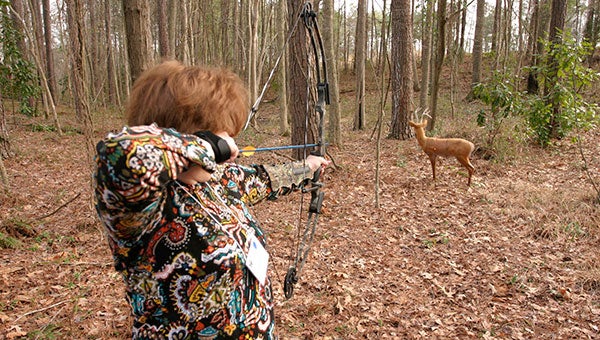Survey results: White-tailed deer still reigns supreme
Published 11:34 pm Friday, February 12, 2016
By David Rainer
The white-tailed deer still reigns supreme for Alabama’s hunters. The Alabama Wildlife and Freshwater Fisheries (WFF) Division’s recent email survey confirms that fact without question.
WFF sent the email survey to 127,000 hunting license holders who bought their licenses online. A total of 12,801 of the email recipients responded to the survey.
“That’s 10 percent, which from everything I can determine is very strong,” said WFF Director Chuck Sykes. “For example, Mississippi sent a similar survey to 267,000 hunters and got 15,000 surveys back. We got back more than 12,000, so I thought that was a pretty good response.”
To illustrate how many hunters pursue white-tailed deer in Alabama, of those 12,801 respondents, 98 percent indicated they hunted deer. Ninety-four percent indicated they had hunted deer in the last two years. Turkey hunters were not as widespread, with 56 percent indicating they were turkey hunters.
“Pretty much anybody who hunts in Alabama is going to hunt deer,” Sykes said. “That didn’t surprise me. This just proves how important deer hunting is to the state. It is what drives the bus, which is why it is so important that we get data that we can manage by.”
The survey was made up of 12 questions, ranging from deer and turkey hunting participation to opinions on mandatory harvest reporting. Visit www.outdooralabama.com/january-2016-hunter-survey-results for complete results.
The answer choices for the questions about whether the hunters supported the mandatory harvest reporting of deer and turkeys were support, oppose and neither support/nor oppose.
The responses from deer hunters on that question showed that 54 percent indicated support, 23 percent were opposed and 23 percent were undecided. Turkey hunters indicated support of 48 percent with only 18 percent opposed and 34 percent undecided.
“To me, the percentage of support between turkey hunters and deer hunters was about the same,” Sykes said. “You were either against it, in my opinion, or you were for it. If you didn’t have an opinion, that meant you didn’t care and it was OK to do it. That’s the way I look at it. Turkey hunters were at about 80 percent that supported it or didn’t care, and deer hunters were at 78 percent. The way I look at it, virtually 80 percent of the people who responded to the survey did not oppose mandatory data collection. It is a vocal minority that opposes this.”
Because of some crossover voting from hunters who pursued game on both public and private land, the percentage of private-land hunters was 91 percent and public-land hunters, 13 percent.
“That did not surprise me one bit,” Sykes said. “About 95 percent of the land in the state is privately owned, so that is what I would expect. More than 90 percent of the hunters hunt on private land, which is another reason we can gather data all we want on the WMAs (Wildlife Management Areas), but the survey shows the portion of hunting that goes on there. It’s not much. That’s why we have to have hunters on private land help us with this data. We cannot do it by sampling WMA hunters.”
WFF proposed mandatory harvest reporting through the Game Check program three years ago, but opposition led to the implementation of a voluntary reporting system.
Sykes said he has proof that the voluntary reporting system did not receive anywhere near the support he had hoped.
In those three years of voluntary reporting, WFF generated reports from just after the Christmas holidays. On Dec. 31, 2013, there had been 11,552 deer harvest reports. On Dec. 29, 2014, the reports had dwindled to 7,408. By Dec. 28, 2015, only 6,341 people had used Game Check to report deer harvests.
“Voluntary reporting does not work,” Sykes said. “The participation steadily went downhill. It’s human nature. If you’re not required to do something, more than likely you’re not going to do it.
“I don’t want this department held responsible for managing such an important resource, which accounts for billions of dollars in economic impact to the state, on a guess. In this day and time, with the technology at our fingertips, that’s unacceptable. We need data to manage it properly.”
Sykes said those who oppose mandatory harvest reporting mistakenly say the reason behind Game Check is so the Enforcement Section can write more tickets for hunting violations.
“Hunters are the ones who want the laws to be enforced,” he said. “I hear it every day. The ones abiding by the laws, like the three-buck limit, are wanting to make sure their neighbors are doing the same thing. They are the ones who are crying out for enforcement
“We want the data. But the two go hand-in-hand. We get the data we need, and they get the enforcement. Everybody wins, especially the resource.”
Sykes said there is a perfect example of what mandatory reporting can achieve on the Alabama Gulf Coast with red snapper data.
“Look at the success of Snapper Check,” he said. “It was able to prove that the federal government overestimated the snapper harvest by double for two consecutive years. Basically, methodology similar to what the feds used on red snapper is being used to estimate deer and turkeys. That’s unacceptable.”
Estimates of the Alabama deer herd range from 1.5 million to 2 million animals, but Sykes says those are only rough estimates, stemming from anecdotal information gathered from a small sample of hunter surveys, landowner visits and reports from hunting clubs.
“We would like to improve our ability to inventory this vital natural resource and also to determine the inventory harvested by hunters on an annual basis to better manage this species,” said Sykes, who pointed out that almost every state in the U.S. has some type of mandatory reporting in the form of tags, check stations, online reporting or telephone hotlines.
“All but three states have some type of data gathering,” he said. “I don’t want Alabama to be the last.”
David Rainer works for the Alabama Department of Conservation and Natural Resources.





